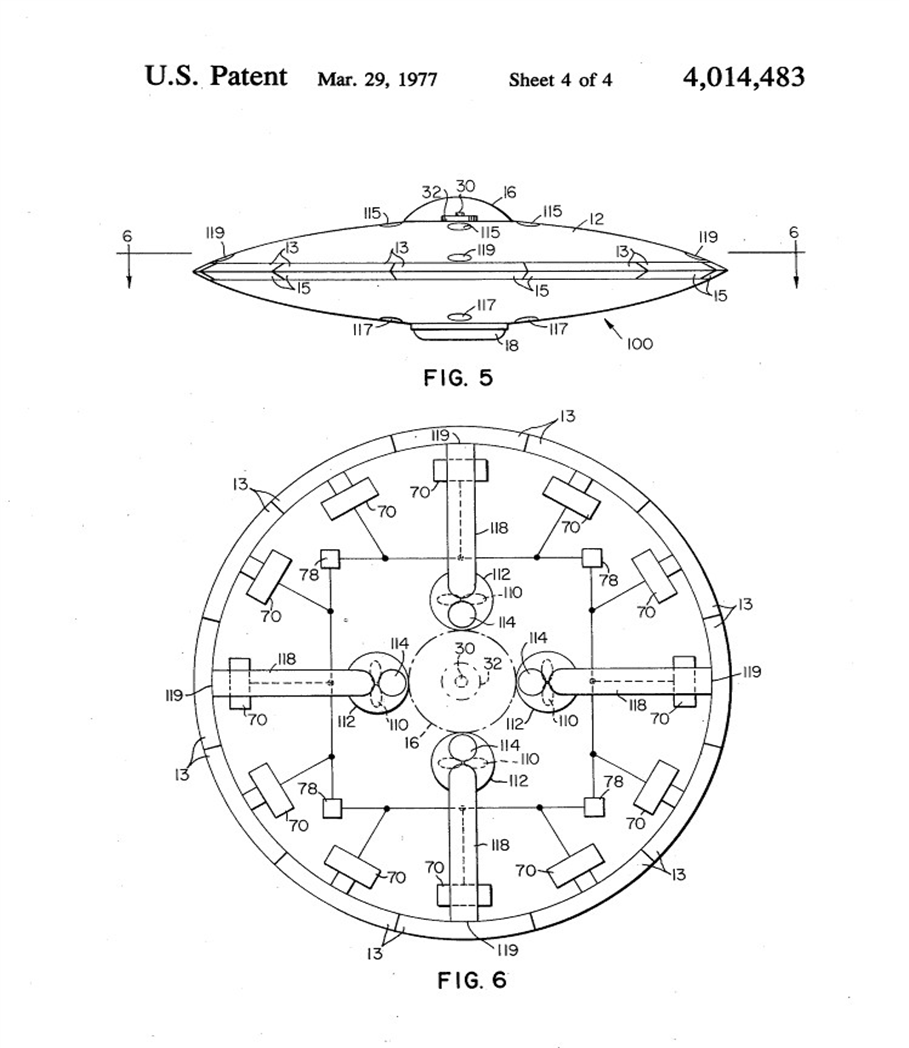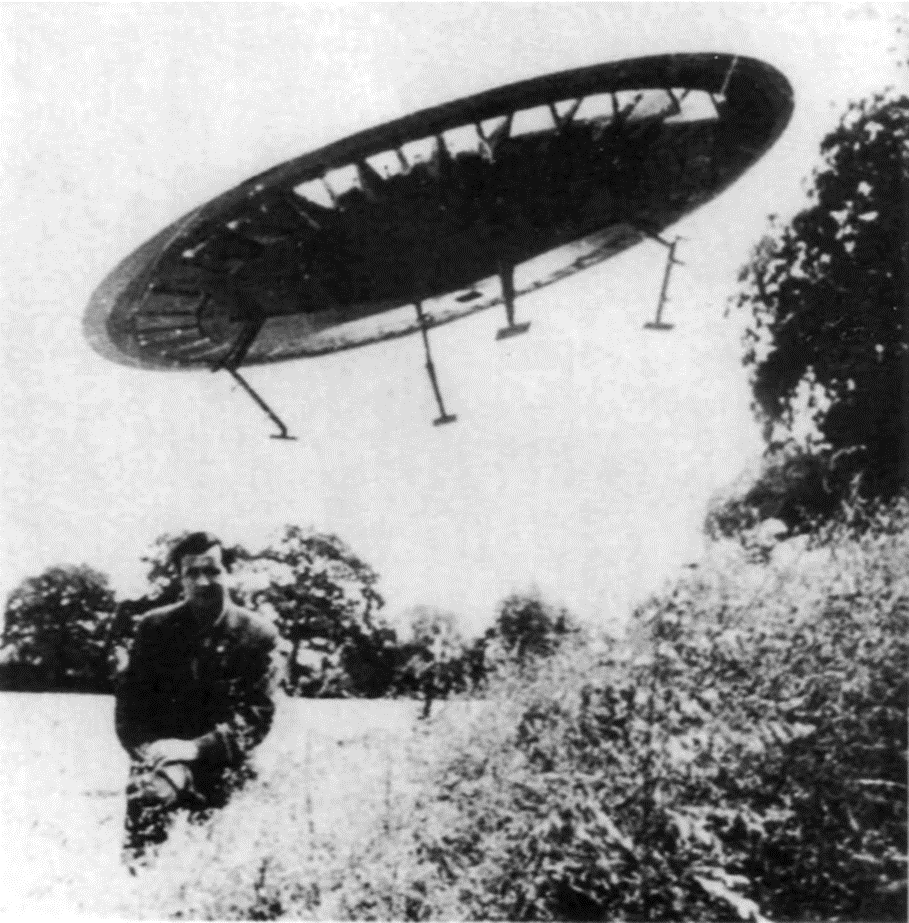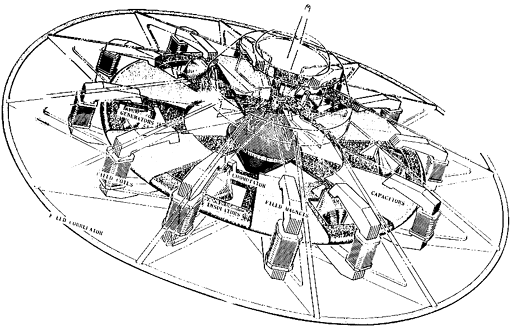Blueprint for Building
Building a vehicle requires a plan

What does the blueprint for building a spacecraft look like? There are a few examples. One example is patent # 4.014.483, awarded to Roderick M. MacNeil (Southborough, MA), March 29,1977.
“SUMMARY
In accordance with this invention, a lighter-than-air craft has a substantially discus shape so as to minimize drag and wind resistance about the craft's circumference. A plurality of ailerons distributed about the circumference of the craft compensate the craft as wind direction and velocity change. Pilot effort in stabilizing the craft therefore is minimized.
In an illustrative embodiment of the craft of this invention, a passenger and crew compartment is located at the top center of the craft, while a payload pod is located at the bottom center beneath the passenger and crew compartment. The pod connects to the passenger and crew compartment by a passageway which extends up through the craft's center. Moreover, the pod is detachable from the craft and can be lowered to the ground with the craft maintained at a considerable altitude above the ground. The craft can thus hover safely above a relatively small ground area to load and unload passengers and cargo, and need land only for periodic maintenance checks and repair.
The invention is pointed out with particularity in the appended claims. The foregoing and other features and advantages of the invention will be better understood by reference to the following detailed description taken in conjunction with the accompanying drawings.”

As explained in its summary, this apparatus is fixed with a plurality of ailerons distributed about the circumference of the craft. It is, in essence; a dirigible with several lighter than air containers distributed throughout its design. For propulsion, the airship is equipped with two jet motors and four fans to push air through four main chambers, influencing the flight control through manipulating the ailerons.
Other patents cited:
3469804 September 1969 Rowan
3514053 May 1970 McGuinness
3752417 August 1973 Lagace
3820744 June 1974 Denton
The second apparatus is:
Patent number 3,469,804, ROTARY AND CIRCULAR SAUCERSHAPED AIRFOIL ARCRAFT, Steven T. Rowan
“ABSTRACT OF THE DISCLOSURE This invention relates to a rotary airfoil aircraft and, more particularly, to a saucer-shaped aircraft capable of both vertical and horizontal flight. Still more specifically, this invention relates to an airfoil aircraft including a. central pilot's control compartment; a circular airfoil wing means rotatably mounted on and extended laterally from the control compartment; and power means pivotally connected to the outer pelriphery of the airfoil wing means to provide vertical, horizontal, and any combination there: of propulsion. This invention also relates to an airfoil aircraft capable of take-off, vertically, flight in all directions, landing anywhere, and having parachute means mounted thereon for soft landing in cases of emergency to provide the utmost in Safety.”
The other three patents on the list are the same dirigible-type, lighter than air, circular saucer-shaped airfoil design aircraft. This type of wingless discus structure as an application of aeronautical engineering design, is an exercise in futility.
For building an efficient spacecraft, both discus design and propulsion system are imperative. A technique of gimbals with gyroscopic action is appropriate to enact rotary driven propulsion. The importance to a ship’s outer hull configuration is a function of propulsion system design: more so than its relevance to aeronautics engineering.
The goal for a discus design is the pursuit of physics. This application of a craft’s outer shell spin motion is with principles of toroidal magnetic fields and spin motion. Specific control of spin motion is an alternative methodology for propulsion. The dynamics of toroidal fields provide the physics engineering to engage principles of a linear induction motor (LIM) for rotational motion.
John Searl created the Inverse Gravity Vehicle (IGV).

Details of his Searl Effect Generator (SEG) are more heavily pursued than design of his flying craft.
Using SEG technology, the IGV is a craft having the ability to elevate and is able to manipulate gravity. The Searl Effect converts energy from its surrounding environment as it flies through the air.
This technology is relevant to efficient energy use. It also has very high-speed travel potential.
Otis Carr, in his spacecraft design postulated the probability for attaining independent inertia. This was proposed by a three section craft, the outer shell having two opposing rotating fields which encompass a neutral position for the center area (the bridge - control and operational center).

Employing gravitational independence from Earth’s gravity, enables the removal of necessity for aerodynamic engineering.
Earth’s rotational spin is 1,000 mph, its rotation around the sun is 66, 060 mph. Both speeds are in a counter-clockwise rotational direction. This means that the design spin of the craft needs to copy this natural counter-clockwise centripetal motion. To be freed from Earth’s gravitational field, the craft’s spin rate has to exceed Earth’s distance traveled at its rotational speed.



